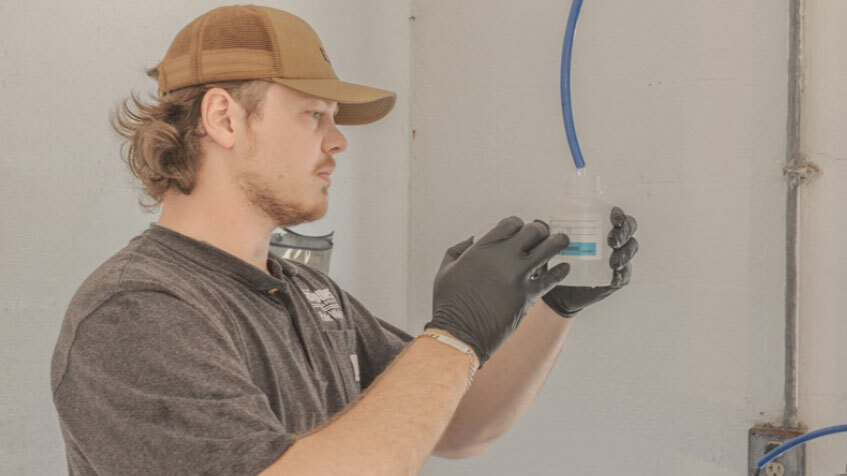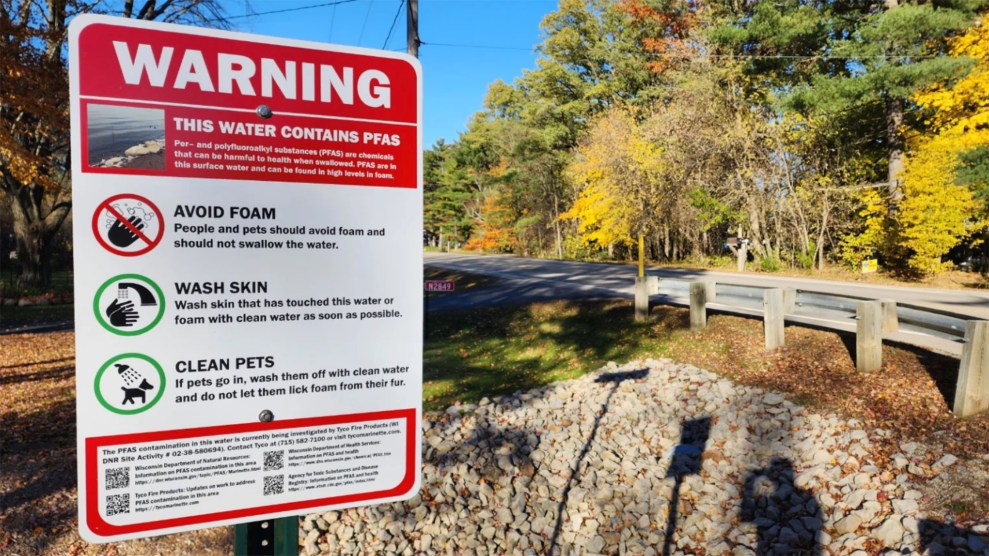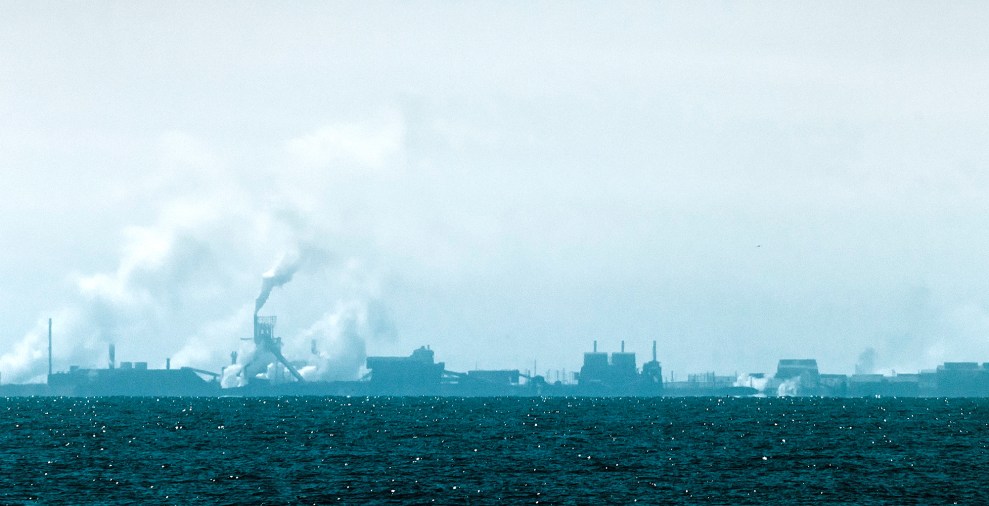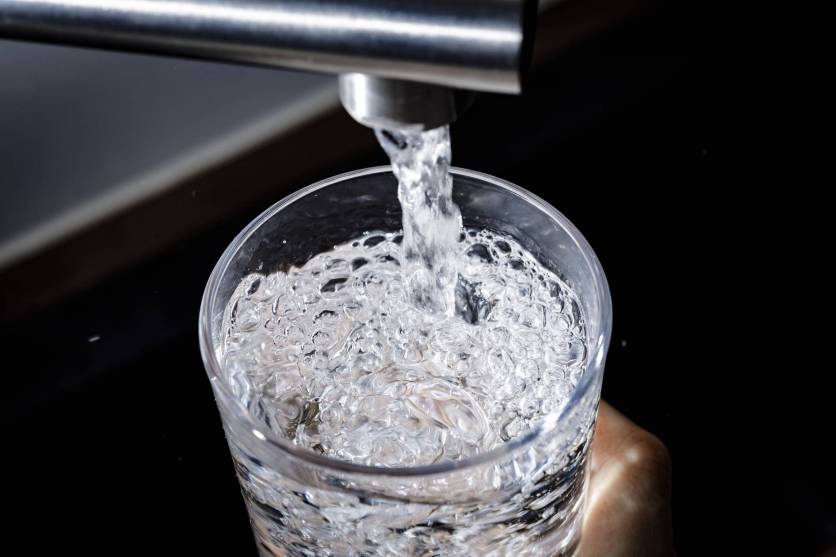
Cole Benak collects a water sample. Kaveer Rai/High Country News
This story was originally published by High Country News and is reproduced here as part of the Climate Desk collaboration.
Just inside the rolled-up door of a pumphouse garage, Cole Benak pulled on a pair of black Nitrile gloves. Outside, morning sunshine warmed the quiet wooded hillside. From the room next door, three massive water pumps whined, pushing thousands of gallons per minute of Vancouver, Washington’s drinking water toward a reservoir another mile uphill. Benak, a city engineering technician, checked his watch and marked the time on a plastic water sampling flask.
He turned and knelt behind a four-foot-wide panel fitted with gauges and valves and four tall, narrow cylinders—like a miniature pipe organ of plastic, each tube filled with water and a different type of filtering material. The water that enters these cylinders, like nearly all of Vancouver’s water, is contaminated with common but dangerous chemicals called PFAS—perfluoroalkyl and polyfluoroalkyl substances. What flows out will help city officials determine which material is best at removing them. Benak opened the valve below one of the filter tubes, letting water first stream onto the concrete, then into the flask.
Vancouver officials first learned about PFAS contamination here in 2020, and they’re still sorting out how to address it. “I have so many questions,” said City Councilmember Sarah Fox. “What things do we need to consider? What are the drawbacks? Who needs to be at the table making some of these decisions?”
Benak screwed the lid onto the bottle and prepared another. His weekly samples are one step in a process that will transform Vancouver’s water system, which serves 270,000 people. But it will come at a high price—at least $170 million, likely far more—and take years to complete. Research showing the health effects of PFAS has evolved far faster than the state and federal regulations that govern water systems, and communities are trying to catch up. The U.S. Environmental Protection Agency’s most recent guidance is that no amount of PFAS contamination is safe, though it is still weighing the first-ever federal standards to regulate them. Achieving zero contamination may not be possible. As the EPA ramps up testing, officials here—and in communities across the U.S.—are grappling with exactly what must be done to keep their water safe.
PFAS are a set of more than 9,000 man-made chemicals prized for being slippery and waterproof. But the qualities that make them useful in clothing, food packaging, factories and firefighting foam make them especially dangerous to human health: Nearly indestructible, they accumulate in the body and have been linked with serious health conditions—cancers, thyroid and liver disorders, weakened immune systems, developmental problems—even at extremely low levels. They leach into the environment wherever they’re used and have been found in blood samples, breast milk, wild animals and rainwater worldwide. The nonprofit Environmental Working Group estimates that the drinking water of at least two-thirds of all US residents is contaminated.
When the Washington State Board of Health began to consider regulating PFAS in drinking water around 2017—as numerous states have done in the absence of EPA rules—Vancouver’s water manager, Tyler Clary, thought his system had nothing to worry about. He’d tested for PFAS in 2013, and found none. Then, in 2020, “we tested new samples and came back with these hits all over the place,” he said. Testing sensitivity had improved, he learned: Retesting old samples revealed that at least two of the city’s aquifers had been contaminated at low levels all along—and that many wells had levels near or above what the state later recommended as safe.
Washington’s standards, implemented in 2021, set limits for several of the most common types of PFAS, including PFOA and PFOS, which were used in products like Teflon and Scotchgard until companies started phasing them out in the early 2000s. The state limits PFOA at 10 parts per trillion (ppt) and PFOS at 15 ppt, both less than a single drop in an Olympic-sized swimming pool.
The EPA’s newest guidelines go further: Newer science shows that no amount is safe. But current test technology can only reliably detect PFOA and PFOS down to about 4 ppt—and so this year, the agency proposed that threshold as the new federal limit, which could take effect by 2026.
This March, Clary’s team sampled water stations again. Most tested between 5 and 22 ppt for PFOA or PFOS. State rules recommend—but don’t require—that water at six of the city’s nine water stations be treated. If the EPA’s proposed standards are enacted, every station but one would need an upgrade.
The shifting standards and evolving science put Clary and city officials in a tricky position, as far as planning and communicating risk to residents. Some Washington cities, including Airway Heights near Spokane, have water so contaminated—often by military use of firefighting foam—that officials immediately shut down wells and brought in other water. In Vancouver, levels are low but so widespread that about half the city’s water falls into a regulatory gray area: Not worrisome by state rules, but exceeding the pending federal standard. And the culprit has not yet been identified, so there is no single polluter to stop or hold accountable.
It’s also difficult to tell residents how much is reaching their homes: Like many municipal systems, water from every station is mixed, and the amount drawn from any one well shifts to meet demand. When demand is low, Clary has been able to decrease use of the most contaminated wells. During peak summer use, he needs to turn that flow up again.
There is good news, though: Filtering PFAS to meet state or federal limits isn’t complicated, and the city has been through a similar process before. Near the pumphouse where Benak takes samples every Tuesday stand two white towers the size of upended school buses that have filtered tetrachloroethylene (PCE), a neurotoxic dry-cleaning chemical, since the ’90s.
Benak’s miniature pilot tanks are measuring how many months it takes before each filter becomes too saturated to work well. The longer a filter lasts, the cheaper the system will be to maintain. A preliminary engineering report suggested media replacement alone could cost Vancouver more than $1 million per year.
Each of the filters has other costs and benefits to consider, too. One of Benak’s test cylinders stands nearly twice as tall as the rest: Filled with granular activated carbon, it’s the media most often used to filter PFOA and PFOS, which cling to the black carbon flakes like nails to a magnet. Activated carbon removes many other contaminants, too, likely including some that aren’t known or regulated yet. Still, it may not be as good at catching newer, smaller types of PFAS that have been widely used to replace PFOA and PFOS but that similarly accumulate to dangerous levels. Activated carbon systems also require a lot of real estate. This single station could require 16 towers, each filled with 60,000 pounds of carbon, that would displace the dog park next door.
The other three cylinders Benak is testing contain unique formulas of resin microbeads—a shiny golden sand-like plastic used for a filtration method called ion exchange. These filters use a reaction similar to static cling: The negative ions of a PFAS molecule stick to the positively charged beads. This process is often better at catching short-chain PFAS, and the towers take up less space: Here, they’d need two-thirds the footprint of a carbon system. But they don’t filter as many other contaminants and are harder to maintain.
Which media works best will also come down to the local water chemistry: Sediments, minerals and other compounds can interfere. Benak and Clary expect that by early next year, they’ll have an idea of which will last the longest. Then, they can develop long-term construction plans and ask the state, federal government and city council for funds.
From there, engineers say systems to meet state limits would take at least six years to complete. The EPA’s pending rules would add time and millions more in costs—though a recent state lawsuit to make PFAS manufacturers pay for water treatment may help.
Councilmembers and the county health department are just starting to consider how to keep residents safe until then. Officials, including Fox, hope that the council or county will seek grant dollars to buy home filters for vulnerable low-income residents. The state already recommends that breastfeeding parents avoid tap water that’s over the state limit, and suggests mixing infant formula with adequately filtered water.
After an hour of pulling samples from all four test cylinders, Benak shut off the last valve. The systems he’s helping to assess aren’t complicated or scary, he said—just really, really big. Packing up the flasks, vials and paperwork, he stepped through the puddle spread across the concrete—Vancouver water, free of detectable PFAS—then set off in his SUV toward the lab.
Correction: Display copy in an earlier version misidentified the town as Vancouver, BC. It is Vancouver, Washington.














